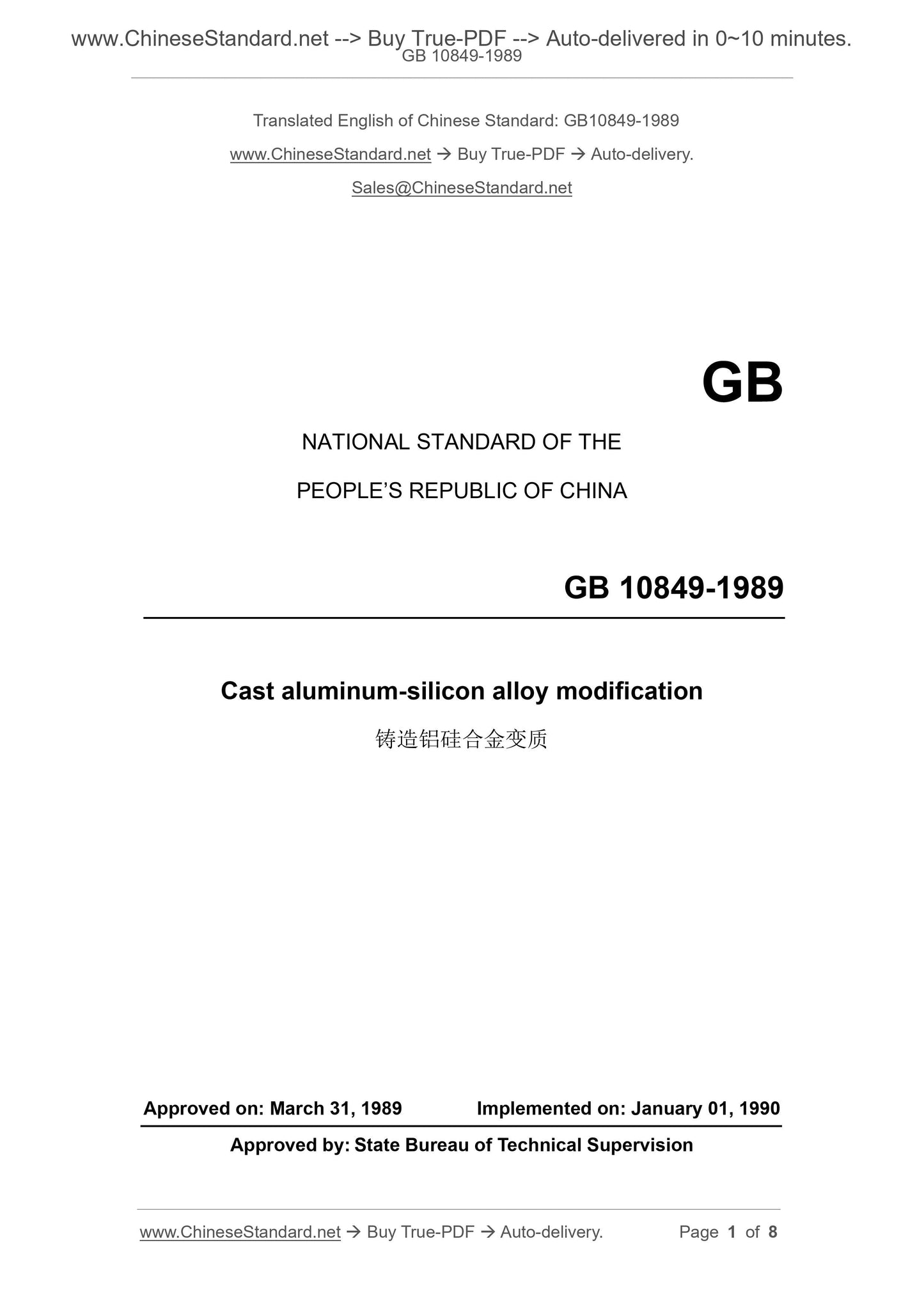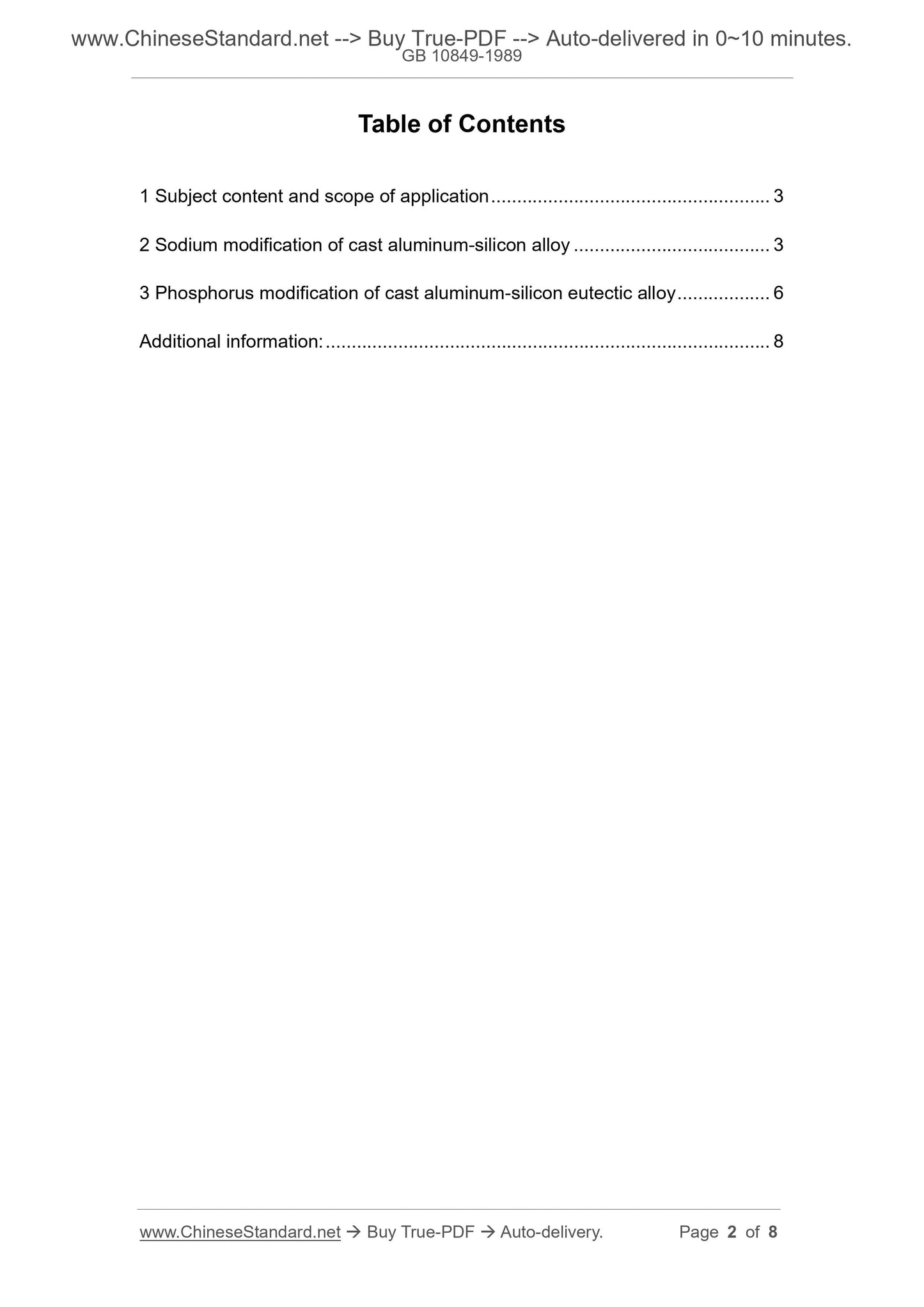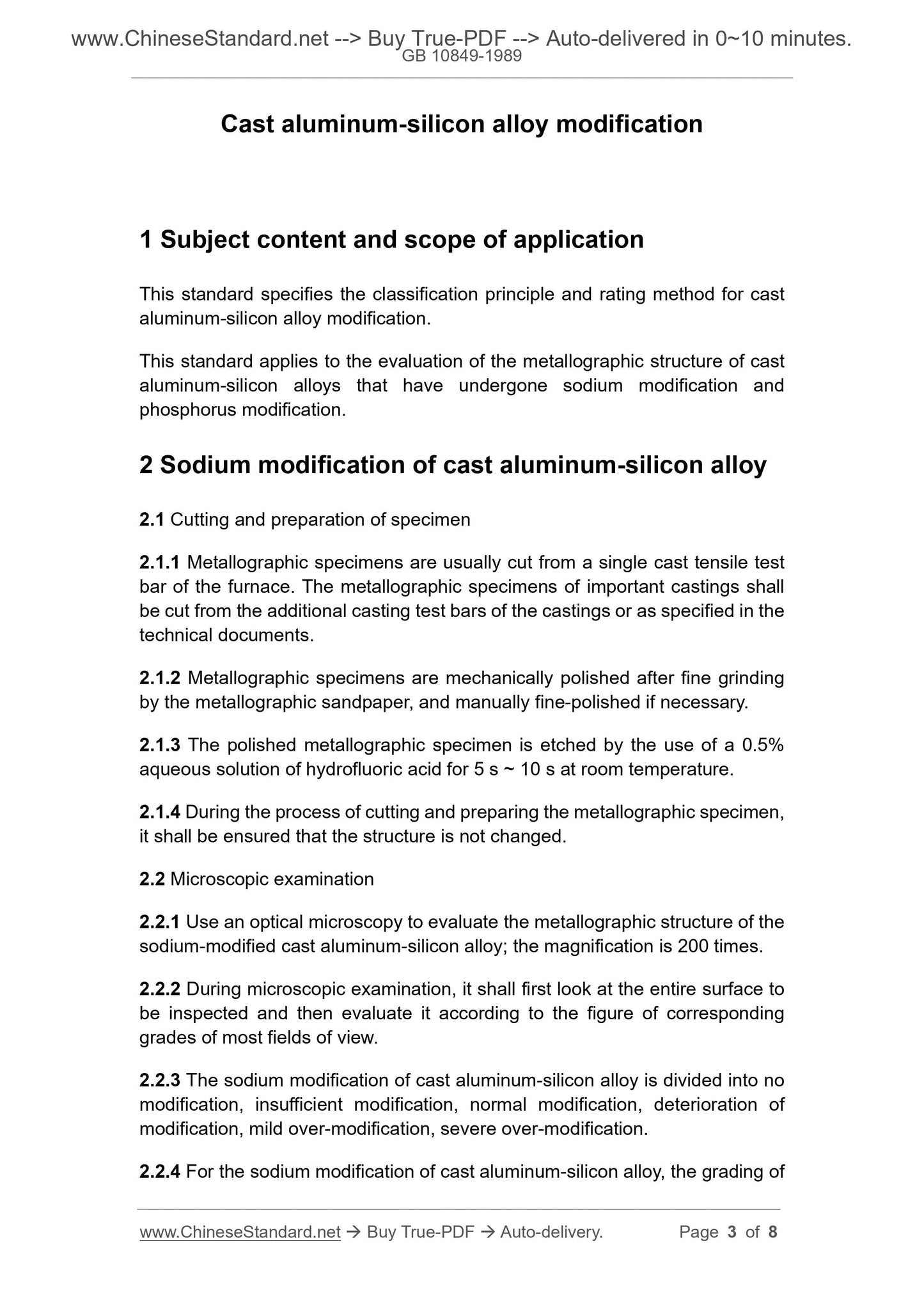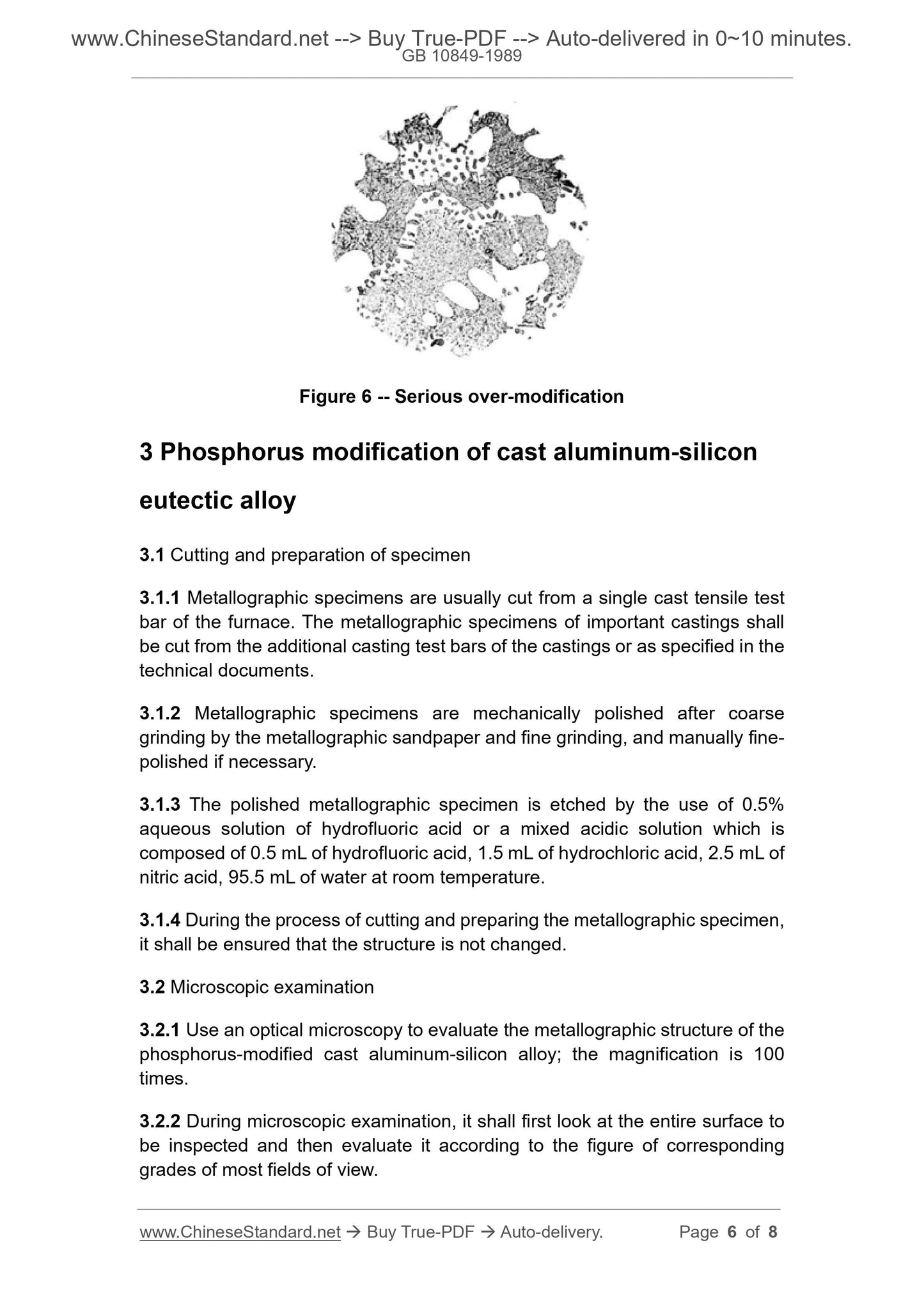1
/
su
4
PayPal, credit cards. Download editable-PDF & invoice In 1 second!
GB 10849-1989 English PDF (GB10849-1989)
GB 10849-1989 English PDF (GB10849-1989)
Prezzo di listino
$165.00 USD
Prezzo di listino
Prezzo scontato
$165.00 USD
Prezzo unitario
/
per
Spese di spedizione calcolate al check-out.
Impossibile caricare la disponibilità di ritiro
Delivery: 3 seconds. Download true-PDF + Invoice.
Get QUOTATION in 1-minute: Click GB 10849-1989
Historical versions: GB 10849-1989
Preview True-PDF (Reload/Scroll if blank)
GB 10849-1989: Cast aluminium-silicon alloys--Modification
GB 10849-1989
NATIONAL STANDARD OF THE
PEOPLE’S REPUBLIC OF CHINA
Cast aluminum-silicon alloy modification
APPROVED ON: MARCH 31, 1989
IMPLEMENTED ON: JANUARY 01, 1990
Approved by: State Bureau of Technical Supervision
Table of Contents
1 Subject content and scope of application ... 3
2 Sodium modification of cast aluminum-silicon alloy ... 3
3 Phosphorus modification of cast aluminum-silicon eutectic alloy ... 6
Additional information: ... 8
Cast aluminum-silicon alloy modification
1 Subject content and scope of application
This standard specifies the classification principle and rating method for cast
aluminum-silicon alloy modification.
This standard applies to the evaluation of the metallographic structure of cast
aluminum-silicon alloys that have undergone sodium modification and
phosphorus modification.
2 Sodium modification of cast aluminum-silicon alloy
2.1 Cutting and preparation of specimen
2.1.1 Metallographic specimens are usually cut from a single cast tensile test
bar of the furnace. The metallographic specimens of important castings shall
be cut from the additional casting test bars of the castings or as specified in the
technical documents.
2.1.2 Metallographic specimens are mechanically polished after fine grinding
by the metallographic sandpaper, and manually fine-polished if necessary.
2.1.3 The polished metallographic specimen is etched by the use of a 0.5%
aqueous solution of hydrofluoric acid for 5 s ~ 10 s at room temperature.
2.1.4 During the process of cutting and preparing the metallographic specimen,
it shall be ensured that the structure is not changed.
2.2 Microscopic examination
2.2.1 Use an optical microscopy to evaluate the metallographic structure of the
sodium-modified cast aluminum-silicon alloy; the magnification is 200 times.
2.2.2 During microscopic examination, it shall first look at the entire surface to
be inspected and then evaluate it according to the figure of corresponding
grades of most fields of view.
2.2.3 The sodium modification of cast aluminum-silicon alloy is divided into no
modification, insufficient modification, normal modification, deterioration of
modification, mild over-modification, severe over-modification.
2.2.4 For the sodium modification of cast aluminum-silicon alloy, the grading of
Figure 6 -- Serious over-modification
3 Phosphorus modification of cast aluminum-silicon
eutectic alloy
3.1 Cutting and preparation of specimen
3.1.1 Metallographic specimens are usually cut from a single cast tensile test
bar of the furnace. The metallographic specimens of important castings shall
be cut from the additional casting test bars of the castings or as specified in the
technical documents.
3.1.2 Metallographic specimens are mechanically polished after coarse
grinding by the metallographic sandpaper and fine grinding, and manually fine-
polished if necessary.
3.1.3 The polished metallographic specimen is etched by the use of 0.5%
aqueous solution of hydrofluoric acid or a mixed acidic solution which is
composed of 0.5 mL of hydrofluoric acid, 1.5 mL of hydrochloric acid, 2.5 mL of
nitric acid, 95.5 mL of water at room temperature.
3.1.4 During the process of cutting and preparing the metallographic specimen,
it shall be ensured that the structure is not changed.
3.2 Microscopic examination
3.2.1 Use an optical microscopy to evaluate the metallographic structure of the
phosphorus-modified cast aluminum-silicon alloy; the magnification is 100
times.
3.2.2 During microscopic examination, it shall first look at the entire surface to
be inspected and then evaluate it according to the figure of corresponding
grades of most fields of view.
Get QUOTATION in 1-minute: Click GB 10849-1989
Historical versions: GB 10849-1989
Preview True-PDF (Reload/Scroll if blank)
GB 10849-1989: Cast aluminium-silicon alloys--Modification
GB 10849-1989
NATIONAL STANDARD OF THE
PEOPLE’S REPUBLIC OF CHINA
Cast aluminum-silicon alloy modification
APPROVED ON: MARCH 31, 1989
IMPLEMENTED ON: JANUARY 01, 1990
Approved by: State Bureau of Technical Supervision
Table of Contents
1 Subject content and scope of application ... 3
2 Sodium modification of cast aluminum-silicon alloy ... 3
3 Phosphorus modification of cast aluminum-silicon eutectic alloy ... 6
Additional information: ... 8
Cast aluminum-silicon alloy modification
1 Subject content and scope of application
This standard specifies the classification principle and rating method for cast
aluminum-silicon alloy modification.
This standard applies to the evaluation of the metallographic structure of cast
aluminum-silicon alloys that have undergone sodium modification and
phosphorus modification.
2 Sodium modification of cast aluminum-silicon alloy
2.1 Cutting and preparation of specimen
2.1.1 Metallographic specimens are usually cut from a single cast tensile test
bar of the furnace. The metallographic specimens of important castings shall
be cut from the additional casting test bars of the castings or as specified in the
technical documents.
2.1.2 Metallographic specimens are mechanically polished after fine grinding
by the metallographic sandpaper, and manually fine-polished if necessary.
2.1.3 The polished metallographic specimen is etched by the use of a 0.5%
aqueous solution of hydrofluoric acid for 5 s ~ 10 s at room temperature.
2.1.4 During the process of cutting and preparing the metallographic specimen,
it shall be ensured that the structure is not changed.
2.2 Microscopic examination
2.2.1 Use an optical microscopy to evaluate the metallographic structure of the
sodium-modified cast aluminum-silicon alloy; the magnification is 200 times.
2.2.2 During microscopic examination, it shall first look at the entire surface to
be inspected and then evaluate it according to the figure of corresponding
grades of most fields of view.
2.2.3 The sodium modification of cast aluminum-silicon alloy is divided into no
modification, insufficient modification, normal modification, deterioration of
modification, mild over-modification, severe over-modification.
2.2.4 For the sodium modification of cast aluminum-silicon alloy, the grading of
Figure 6 -- Serious over-modification
3 Phosphorus modification of cast aluminum-silicon
eutectic alloy
3.1 Cutting and preparation of specimen
3.1.1 Metallographic specimens are usually cut from a single cast tensile test
bar of the furnace. The metallographic specimens of important castings shall
be cut from the additional casting test bars of the castings or as specified in the
technical documents.
3.1.2 Metallographic specimens are mechanically polished after coarse
grinding by the metallographic sandpaper and fine grinding, and manually fine-
polished if necessary.
3.1.3 The polished metallographic specimen is etched by the use of 0.5%
aqueous solution of hydrofluoric acid or a mixed acidic solution which is
composed of 0.5 mL of hydrofluoric acid, 1.5 mL of hydrochloric acid, 2.5 mL of
nitric acid, 95.5 mL of water at room temperature.
3.1.4 During the process of cutting and preparing the metallographic specimen,
it shall be ensured that the structure is not changed.
3.2 Microscopic examination
3.2.1 Use an optical microscopy to evaluate the metallographic structure of the
phosphorus-modified cast aluminum-silicon alloy; the magnification is 100
times.
3.2.2 During microscopic examination, it shall first look at the entire surface to
be inspected and then evaluate it according to the figure of corresponding
grades of most fields of view.
Share








